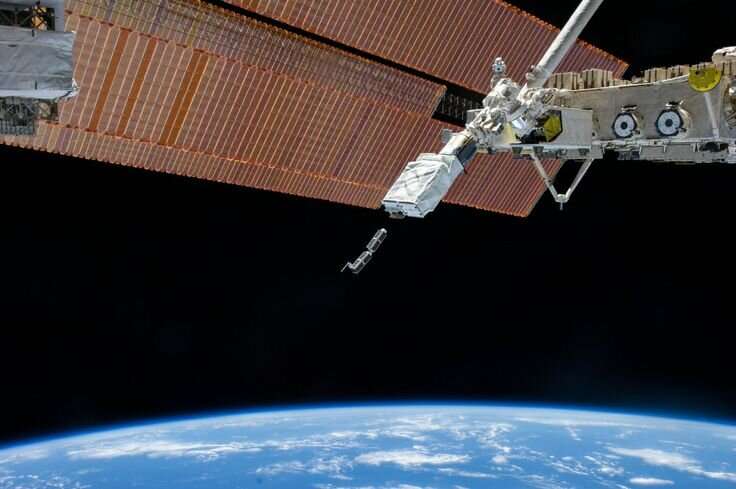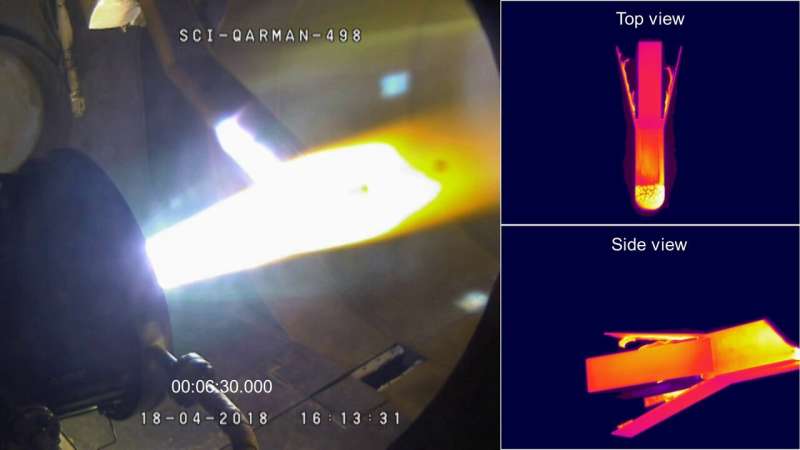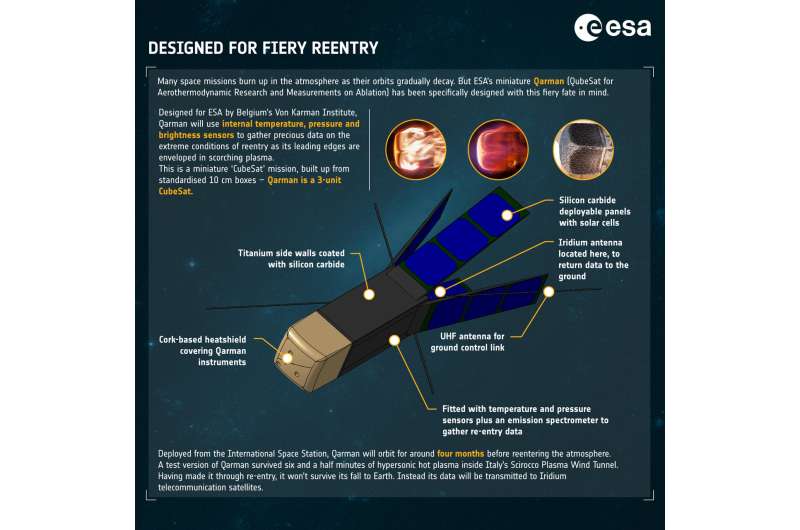Qarman CubeSat: Falling into a fireball

This Wednesday 12 February, ESA's latest mission will enter the vacuum of space, not aboard a rocket but by being released from the International Space Station. The first task of the shoebox-sized Qarman CubeSat is simply to fall. While typical space missions resist orbital decay, Qarman will drift down month by month until it reenters the atmosphere, at which point it will gather a wealth of data on the fiery physics of reentry.
Technically ESA's 'QubeSat for Aerothermodynamic Research and Measurements on Ablation', Qarman, achieved orbit on 5 December, flying as cargo on SpaceX's Dragon capsule to the ISS. The nanosatellite is a CubeSat made up of standardized 10-cm boxes: at just 30 cm in length it easily fitted aboard, stowed within the commercial Nanoracks CubeSat Deployment System.
But on Wednesday comes the ambitious mini-mission's next giant leap. Astronaut Andrew 'Drew' Morgan will take the Nanoracks deployer and place it thorough the airlock of Japan's Kibo module. From here the module's robotic arm—the Japanese Experimental Module Remote Manipulator System—will position the deployer for safe orientation away from the station, then Qarman will be shot into space.
"From there we think it will take about six months to reenter the atmosphere—to find out how accurately we can forecast Qarman's orbital decay is part of the reason we're flying the mission, relevant to the study of space debris," explains Prof. Olivier Chazot, heading the Aeronautic/Aerospace Department of the Von Karman Institute in Belgium. This internationally sponsored centre of excellence for fluid dynamics developed the Qarman mission in partnership with ESA's technical specialists in the Directorate of Technology, Engineering and Quality at ESTEC in the Netherlands.

Form follows function: Qarman's distinctive shuttlecock-like profile, with its quartet of deployable solar-array covered panels, is designed to increase atmospheric drag on the tiny CubeSat, hastening its fall back to Earth.
"Then, once the reentry process begins, at about 90 km altitude, these panels will keep the satellite's orientation stable, minimizing any tumbling," adds Prof. Chazot.
"For maximum stability we need to have its center of gravity towards the front and center of pressure at the back, and deploying the panels moves the center of pressure rearward.
"This will help focus heating on Qarman's square-shaped nose, which is made from cork—not the sort you find in champagne bottles but a carefully tailored aerospace variety, supplied by Portuguese company Amorim and used in numerous spacecraft thermal protection systems."

When cork heats up the material first swells, then chars then finally flakes away, carrying away unwanted heat with it. It is this 'ablation' process that the Qarman team want to study.
"Ablation is a tried and tested thermal protection method, used for instance by ESA's Intermediate Experimental Vehicle, IXV," says Prof. Chazot. "We will check our classical understanding of the process against observed reality using thermocouples, pressure sensors and also a spectrometer embedded under the cork in Qarman's nose. Looking out with a small camera we'll be able to measure the spectra of the flow radiation in the shock layer as well as species emitted by the burning cork."
The stability provided by Qarman's side panels and front center of gravity should also allow the CubeSat to transmit its findings to commercial Iridium telecommunication satellites—planning to transmit around 20 minutes of reentry data in three to five minutes.

An inner 'survival kit' containing instruments and electronics and lined with protective ceramic carbon matrix with aerogel protection will likely survive reentry but will not be recovered, most likely splashing down in the sea.
"We've played a role in many ESA programs, such as the IXV, the forthcoming Space Rider reusable spacecraft, as well as the Vega-C and Ariane 6 launchers," notes Prof. Chazot, "but up until now we've focused on the modeling and experimental simulation side.
"These kind of tests cannot tell you everything we want to know however—to really validate our codes and understand the reality of the physics involved, we need to actually fly in space.
"The idea came to design our own CubeSat when we were running the European Commission-led QB50 program, which was an international CubeSat network to perform lower atmosphere and reentry research. We designed and built the entire mission, buying in parts and expertise as needed, with valuable technical and organizational support coming from ESA. As a follow-up we are interested in designing a recoverable 'black box' reentry mission."
Provided by European Space Agency





















